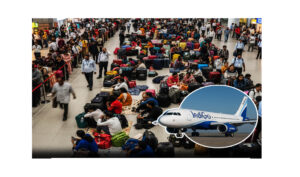സംസ്ഥാനങ്ങളുടെ ശരാശരി ജിഡിപി വളര്ച്ച 11.2 ശതമാനം

konnivartha.com: കൊച്ചി: സംസ്ഥാനങ്ങളുടെ ശരാശരി ജിഡിപി വളര്ച്ച കഴിഞ്ഞ സാമ്പത്തിക വര്ഷത്തിലെ 11.8 ശതമാനത്തില് നിന്ന് 11.2 ശതമാനമായി കുറഞ്ഞതായി നാഷണല് സ്റ്റോക് എക്സ്ചേഞ്ചിന്റെ (എന്എസ്ഇ) വിലയിരുത്തല് ചൂണ്ടിക്കാട്ടുന്നു. 21 സംസ്ഥാനങ്ങളുടെ ബജറ്റുകള് വിശകലനം ചെയ്താണ് എന്എസ്ഇ ഇക്കാര്യം ചൂണ്ടിക്കാട്ടിയത്.
മധ്യപ്രദേശിന്റെ കാര്യത്തില് ഇത് 0.6 ശതമാനമാണെങ്കില് മിസോറാമിന്റെ കാര്യത്തില് 22.1 ശതമാനമാണ് എന്ന രീതിയില് ഗണ്യമായ വ്യത്യാസമാണ് വിവിധ സംസ്ഥാനങ്ങളുടെ കാര്യത്തിലുള്ളത്. റവന്യൂ വരുമാനത്തിന്റെ കാര്യത്തില് 10.6 ശതമാനം വര്ധനവും ഉണ്ടായിട്ടുണ്ട്. സംസ്ഥാനങ്ങളുടെ മൂലധന ചെലവുകള് മൂന്നു വര്ഷം ശക്തമായി ഉയര്ന്ന ശേഷം 2025 സാമ്പത്തിക വര്ഷത്തില് മിതമായ തോതിലേക്ക് എത്തുമെന്നാണ് പ്രതീക്ഷിക്കുന്നത്.
പഞ്ചാബ്, കേരളം, ഹിമാചല് പ്രദേശ് തമിഴ്നാട് എന്നീ സംസ്ഥാനങ്ങള് റവന്യൂ വരുമാനത്തിന്റെ 35 ശതമാനം 2025 സാമ്പത്തിക വര്ഷത്തിലെ പ്രതിജ്ഞാബദ്ധമായ ചെലവുകള്ക്കായി നീക്കിവച്ചിട്ടുണ്ട്.
21 സംസ്ഥാനങ്ങളുടെ ആകെ റവന്യൂ കമ്മി 10 ലക്ഷം കോടി രൂപയാണ്. നികുതി വരുമാനത്തിന്റെ 30 ശതമാനം മാത്രം സംഭാവന ചെയ്യുന്ന സംസ്ഥാനങ്ങള്ക്ക് മൊത്തം സര്ക്കാര് ചെലവിന്റെ 60 ശതമാനത്തിന് മുകളില് ബാധ്യതയാണ്. സാമ്പത്തിക നില മെച്ചപ്പെടുത്തേണ്ടത് കൂടുതല് നിര്ണായകമാണെന്നാണ് ഇതു സൂചിപ്പിക്കുന്നത്.
State Budget Analysis by National Stock Exchange (NSE):Capex pace moderates in FY25BE
The analysis of FY25 budgets for 21 states, together representing over 95% of India’s
GDP (Rs 326 lakh crore in FY25BE), reveals important insights into their financial
health.
The average GDP growth for these states is projected at 11.2%, down from
11.8% in FY24RE, with significant inter-state variation (0.6% for MP to 22.1% for
Mizoram), exceeding India’s budgeted growth of 10.5%. Total receipts are expected to
rise by a four-year low of 10.2% to Rs 43.4 lakh crore (+16.7% in FY24RE), with
revenue receipts (99% of total receipts) rising by 10.6%. This growth is primarily
driven by a strong, albeit sequentially lower, 15% rise in states’ own revenues (tax and
non-tax) to Rs 25.8 lakh crore, partly offset by lower devolution and grants from the
Centre. Tax buoyancy for these states is expected to remain steady at 1.3x in FY25BE,
surpassing the Centre’s 1.0x.
After three years of strong growth, capital spending by states is expected to moderate in
FY25, growing by a modest 6.5% to Rs 6.5 lakh crore, down from a strong 39.3% growth
in FY24RE. The capital-to-revenue expenditure ratio, a measure of expenditure quality,
is set at 20.7% for FY25BE, declining from 21.2% in FY24RE. Punjab has the lowest
ratio at 6.2%, while Gujarat leads at 36.2%. Revenue expenditure is also budgeted to
increase by a four-year low of 8.9% to Rs 44.2 lakh crore. Committed expenditure
(interest payments and pensions), on the other hand, remains high, comprising about
24% of total revenue expenditure and consuming nearly a quarter of revenue receipts.
Punjab, Kerala, Himachal Pradesh, and Tamil Nadu have allocated over 35% of their
revenue receipts to committed expenditure in FY25.
The overall fiscal deficit of these 21 states is pegged at Rs 10 lakh crore or 3.2% of their
GSDP in FY25BE vs. 3.5% in FY24RE, above the recommended 3.0% by the 15th Finance
Commission. Eight of these 21 states have budgeted for a sub-3% fisc, led by Jharkhand
(2%), Gujarat (2.5%) and Maharashtra (2.6%). Nearly 79% of this deficit is expected to
be funded through market loans, with gross borrowings rising by 7% to Rs 10.8 lakh
crore. States’ reliance on market loans has dropped in the recent years, thanks to higher
loans from the Centre. Outstanding liabilities to GDP ratio at 29% in FY22 for our
sample states may rise to ~33% after accounting for contingent liabilities (states’
guarantees to SPSEs). In our sample, UP accounts for over 19% of the overall contingent
liabilities, followed by Telangana at 15% and Andhra Pradesh at 13%.
With states contributing only 30% of total tax revenues but accounting for over 60% of
total general government expenditure, improving their financial positions has become
increasingly critical. Our analysis highlights the need for a clear fiscal consolidation
roadmap for fiscally strained states, a gradual reduction in contingent liabilities to
enhance transparency, improved fiscal credibility, and risk-based pricing for State
Development Loans (SDLs). These measures are essential for the long-term fiscal health
of states, ensuring they are adequately equipped to address exigencies and emerging
priorities in an ever-changing landscape.



